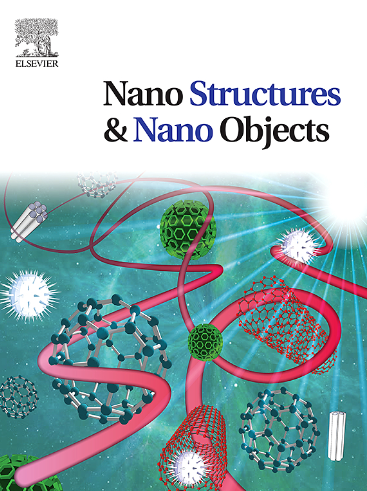多孔介质上具有辐射传热的单壁和多壁碳纳米管:达西-福希海默和导热特性
IF 5.45
Q1 Physics and Astronomy
引用次数: 0
摘要
目前的工作是出于提高导热性的需要,使其在电子、汽车散热器和热交换器的冷却系统中有用。单壁和多壁碳纳米管(CNTs)以其优异的导热性而闻名,使其成为增强传热的有希望的候选者。这里考虑了两种类型的碳纳米管,即单壁碳纳米管(SWCNTs)和多壁碳纳米管(MWCNTs)。SWCNTs,MWCNTs在流体力学中有许多应用。当前研究的目的是考虑Navier 's Stokes方程的经典问题,并开发SWCNTs三维Darcy-Forchheimer流动的数学模型。具有可变热导率和对流边界约束的弹性表面上的MWCNTs碳纳米管。该模型还考虑了热辐射、旋转效应和速度滑移的影响。采用一种合适的变换方法,将无量纲控制偏微分方程转化为常微分方程。采用Bvp4c MATLAB包编制了高度非线性耦合偏微分方程的数值格式。使用的参数范围是:(0.1 & lt;Ω& lt; 1.2), (0.1 & lt; K< 1.2), (0.1 & lt; Fr< 1.2), (0.0 & lt;ϕ& lt; 0.3), (0.1 & lt;є& lt; 1.5), (0.1 & lt; Rd< 1.2), (0.1 & lt; Bi< 1.5)和(0.1 & lt;λ& lt; 1.5)。旋转参数、普朗特数、速度滑移参数、惯性系数、Biot数、变导热系数和辐射参数等各种流动因素对速度、温度曲线的影响结果以图表的形式进行了说明。我们的调查证实了目前的结果,由于旋转参数的创新,流体温度升高。目前的研究结果将对流变性控制、增强机械性能和减少阻力非常有益。本文章由计算机程序翻译,如有差异,请以英文原文为准。
Single and multi-walled carbon nanotubes with radiative heat transfer over a porous medium: Featuring of Darcy–Forchheimer and thermal conductivity
The present work is motivated by the need to enhance thermal conductivity, making them useful in cooling systems for electronics, automotive radiators, and heat exchangers. Single and multi-walled carbon nanotubes (CNTs) are renowned for their exceptional thermal conductivity, making them promising candidates for heat transfer enhancements. Two sorts of carbon nanotubes are reflected here i.e. single wall carbon nanotubes (SWCNTs) and multi-wall carbon nanotubes (MWCNTs) are considered here. SWCNTs & MWCNTs have numerous applications in fluid mechanics. The purpose of the current investigation is to consider a classical problem of Navier’s Stokes equations and develop a mathematical for 3D Darcy–Forchheimer flow of SWCNTs & MWCNTs carbon nanotubes over a stretchy surface with variable thermal conductivity and convective boundary constraints. The impact of thermal radiation, rotational effect, and velocity slip are also taken into account in the present model. A suitable transformation approach was implemented to convert the non-dimensional governing partial differential equation (PDEs) to ordinary differential equation (ODEs) ones. The transformed versions of the highly nonlinear coupled PDEs are drafted by adopting numerical scheme with Bvp4c MATLAB package. The ranges of the parameters used are: , , , , , , and . Outcomes of the various flow factors like rotational parameters, Prandtl number, velocity slip parameter, inertia coefficient, Biot number, variable thermal conductivity, and radiation parameter on velocity, temperature profiles are illustrated graphically and in the form of tables. Our inquiry authenticates the current results, fluid temperature rises due to the innovation of the rotational parameter. Current findings would be extremely beneficial for rheological control, enhancement of mechanical properties and drag reduction.
求助全文
通过发布文献求助,成功后即可免费获取论文全文。
去求助
来源期刊

Nano-Structures & Nano-Objects
Physics and Astronomy-Condensed Matter Physics
CiteScore
9.20
自引率
0.00%
发文量
60
审稿时长
22 days
期刊介绍:
Nano-Structures & Nano-Objects is a new journal devoted to all aspects of the synthesis and the properties of this new flourishing domain. The journal is devoted to novel architectures at the nano-level with an emphasis on new synthesis and characterization methods. The journal is focused on the objects rather than on their applications. However, the research for new applications of original nano-structures & nano-objects in various fields such as nano-electronics, energy conversion, catalysis, drug delivery and nano-medicine is also welcome. The scope of Nano-Structures & Nano-Objects involves: -Metal and alloy nanoparticles with complex nanostructures such as shape control, core-shell and dumbells -Oxide nanoparticles and nanostructures, with complex oxide/metal, oxide/surface and oxide /organic interfaces -Inorganic semi-conducting nanoparticles (quantum dots) with an emphasis on new phases, structures, shapes and complexity -Nanostructures involving molecular inorganic species such as nanoparticles of coordination compounds, molecular magnets, spin transition nanoparticles etc. or organic nano-objects, in particular for molecular electronics -Nanostructured materials such as nano-MOFs and nano-zeolites -Hetero-junctions between molecules and nano-objects, between different nano-objects & nanostructures or between nano-objects & nanostructures and surfaces -Methods of characterization specific of the nano size or adapted for the nano size such as X-ray and neutron scattering, light scattering, NMR, Raman, Plasmonics, near field microscopies, various TEM and SEM techniques, magnetic studies, etc .
 求助内容:
求助内容: 应助结果提醒方式:
应助结果提醒方式:


